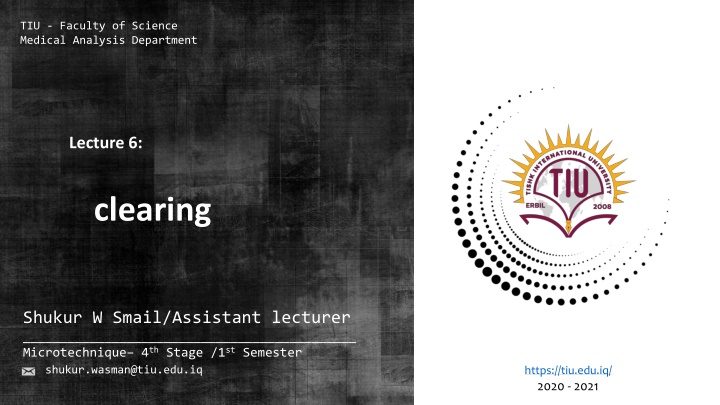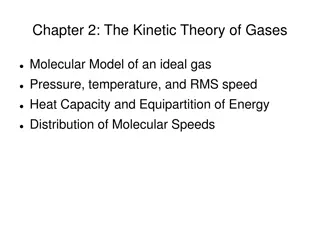Clearing Process in Microtechnique: Techniques, Characteristics, and Ideal Agent
Clearing in microtechnique involves the removal of alcohol or dehydrating agents from tissues and replacing them with a solvent to dissolve wax or mounting medium. The aim is to achieve tissue transparency. Characteristics of a good clearing agent include miscibility with alcohol and wax, non-damaging properties, and transparency enhancement. An ideal clearing agent should have low viscosity, high penetration rate, low toxicity, and be cost-effective.
Download Presentation

Please find below an Image/Link to download the presentation.
The content on the website is provided AS IS for your information and personal use only. It may not be sold, licensed, or shared on other websites without obtaining consent from the author.If you encounter any issues during the download, it is possible that the publisher has removed the file from their server.
You are allowed to download the files provided on this website for personal or commercial use, subject to the condition that they are used lawfully. All files are the property of their respective owners.
The content on the website is provided AS IS for your information and personal use only. It may not be sold, licensed, or shared on other websites without obtaining consent from the author.
E N D
Presentation Transcript
TIU - Faculty of Science Medical Analysis Department Lecture 6: clearing Shukur W Smail/Assistant lecturer _____________________________________________ Microtechnique 4th Stage /1st Semester shukur.wasman@tiu.edu.iq https://tiu.edu.iq/ 2020 - 2021
clearing Process where the alcohol or a dehydrating agent is removed from the tissue and replaced with a substance that will dissolve the wax with which the tissue is to be impregnated or the medium on which the tissue is to be mounted When the dehydrating agent has been entirely replaced by the solvent, tissue has a translucent appearance
Aims of clearing agents Most of these tissues have similar refractive index to that of protein, therefore the tissue is left translucent. Clearing agent is required when the dehydrating agent is not miscible with the impregnating medium. It is essential for a clearing agent to be miscible both in dehydrating agent as well as embedding agent.
Techniques of clearing Techniques of clearing If the tissue is being cleared in chloroform or carbon tetrachloride it may be left overnight. In automatic tissue processor three changes of one hour each are usually satisfactory. In Xylene, benzene or toluene one change after 30-60 minutes is satisfactory to give a clear translucent appearance to the tissue.
clearing Characteristics of a Good Clearing Agent: 1. Should be miscible with alcohol 2. Should be miscible with and easily removed by melted paraffin wax and/or mounting medium 3. Should not produce excessive shrinkage, hardening or damage of tissue 4. Should not dissolve out aniline dyes 5. Should not evaporate quickly in a water bath 6. Should make tissues transparent
Ideal clearing agent: Low viscosity and high penetration rate Low melting point Miscible with both alcohol and molten wax No tissue damage Less toxic Less inflammable Cheap
clearing Most clearing agents are flammable liquids Common Clearing Agents Used: 1. Xylene 2. Toluene 3. Benzene 4. Chloroform 5. Cedarwood oil 6. Aniline oil 7. Clove oil 8. Carbon tetrachloride
clearing A . Xylene (xylol) Colorless agent most commonly used in histo lab Clearing time is to 1 hour Used for clearing, both for embedding and mounting procedures Suitable for most routine histologic processing schedules of <24 hours - tissue block is <5mm in thickness
xylene Advantages: - Most rapid clearing agent - Makes tissues transparent - Miscible with absolute alcohol and paraffin - Does not extract out aniline dyes - For mounting procedures, does not dissolve celloidin - Evaporates quickly in paraffin oven and can be replaced by wax during impregnation and embedding - Cheap
xylene Disadvantages: - Highly inflammable and should be appropriately stored - Makes tissues excessively hard and brittle if used > 3 hours - Causes considerable hardening and shrinkage of tissues; not suitable for nervous tissues and lymph nodes - Becomes milky when incompletely dehydrated tissue is immersed in it
toluene B. TOLUENE May be used as substitute for xylene or benzene for clearing both during embedding and mounting process Clearing time : 1 2 hours ADVANTAGES: - Miscible with both absolute alcohol and paraffin - Acts fairly rapidly; recommended for routine purposes - Tissues do not become excessively hard and brittle even if left for 24 hours - Not carcinogenic
toluene DISADVANTAGES: - Relatively slower than benzene and xylene - Tends to acidify in a partially filled vessel - Highly concentrated solutions emit fumes that are toxic upon prolonged exposure - More expensive
benzene C. BENZENE Penetrates and clear tissues rapidly ADVANTAGES: - Rapid acting; recommended for urgent biopsies (15-60 minutes) and routine purposes - Volatilizes rapidly in paraffin oven (easily sliminated from the tissues) - Miscible with absolute alcohol - Does not make tissues hard and brittle - Causes minimum shrinkage - Makes tissues transparent
benzene DISADVANTAGES: - Highly inflammable - Cause tissue shrinkage when left in a long period of time - Excessive exposure will be toxic to man and become carcinogenic or may damage the bone marrow causing aplastic anemia. Room should be well ventilated if used.
chloroform D. CHLOROFORM Slower in action than xylene, but cause less brittleness Thicker tissue blocks (up to 1 cm thickness) can be processed Tissues do not become translucent ADVANTAGES: - Recommended for routine work (6 24 hours) - Miscible with absolute alcohol - Recommended for tough tissues( ex., skin, fibroid and decalcified tissues) for nervous tissues, lymph nodes and embryos causes minimum shrinkage and hardening of tissues - Suitable for large tissue specimens - Not inflammable
chloroform DISADVANTAGES: - Toxic to the liver after prolonged inhalation - Wax impregnation is slow - Does not make tissues transparent - Not very volatile in paraffin; difficult to remove from paraffin sections - Complete clearing is difficult to evaluate - Evaporates quickly from the water bath - Tissues tend to float in chloroform
Cedarwood oil E. CEDARWOOD OIL Used to clear both paraffin and celloidin sections during embedding process Recommended for central nervous system tissues and cytological studies, particularly smooth muscles and skin Clearing time : 2 3 days ADVANTAGES: - Very penetrating - Miscible with 96% alcohol - Clears celloidin in 5 6 days - Causes minimal shrinkage and hardening of tissues - Tissues may be left in oil indefinitely without considerable damage and distortion - Does not dissolve out aniline dyes - Makes tissues transparent - Improves cutting of the sections
Cedarwood oil DISADVANTAGES: - Slow clearing agent, not recommended for routine purposes - Hard to be eliminated from tissues in paraffin bath, making impregnation slow - Quality is not always uniform and good - Oil becomes milky upon prolonged storage (filtered before use) - Very expensive
Aniline oil / clove oil F. ANILINE OIL Not normally utilized as routine clearing agent Recommended for clearing embryos, insects and very delicate specimens due to inability to clear 70% alcohol without excessive tissue shrinkage and hardening G. CLOVE OIL Causes minimum shrinkage of tissues Wax impregnation is slow and difficult Tissues become brittle, aniline dyes are removed and celloidin is dissolved Expensive, unsuitable for routine clearing purposes
Carbon tetrachloride/methyl salicylate and methyl benzoate H. CARBON TETRACHLORIDE Properties is similar to chloroform; cheaper Disadvantages is similar to chloroform I. METHYL BENZOATE AND METHYL SALICYLATE Slow acting clearing agents; used when double embedding techniques are required
Thanks for your attention @tiu.edu.iq























